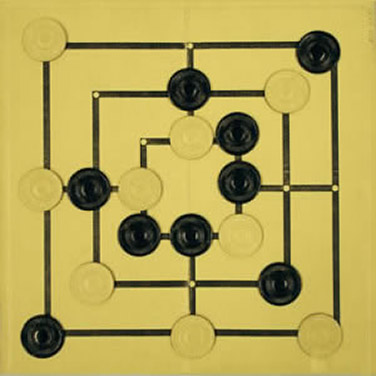Nine Men's Morris

Nine Men's Morris is a board game for two players with nine white and nine black pieces. The aim of the game is to form "mills", i.e. three pieces in a row, thereby taking one opponent's piece after another. The beginning of the game, where the players take it in turns to place their pieces on the board's twenty-four intersection or corner points, is followed by the move phase, where the pieces are moved alternately to adjacent vacant points. In the final phase, a player who only has three pieces left can jump to any vacant point on the board. The player with only two pieces left at the end is the loser.
History
Nine Men's Morris belongs to the "three-in-a-row" game family. Besides the common Twelve and Nine Men's Morris today, there are also smaller versions of the game, such as Six or Three Men's Morris (a square board with three-by-three points and three pieces each). Nine-Men's-Morris-style patterns and boards are found carved in clay or stone virtually all over the world, some even dating back to before Christ. Six Men's Morris is known to date back to around 500 BC and the smaller versions of the game were also popular in Ancient Rome, with Roman legionaries taking them to the four corners of the Roman Empire. Nine Men's Morris enjoyed immense popularity in the late Middle Ages.
Mathematics
The memory capacity in today's computers enables the creation of extensive databases of game positions and their evaluation, which can be used to analyse games of strategy like Nine Men's Morris. At ETH Zurich in 1994, Jürg Nievergelt and Ralph Gasser proved that a game played correctly by both players always ends in a draw. The calculations this required, for which several computers and programmes were used, stretched over three years with interruptions. This fact does not have any consequences for games without the aid of computers, however, as the strategies are sufficiently complex.